A key factor in the beet sugar vs cane sugar debate is how each kind impacts baking.
Discover the Uses and Advantages of Beet Sugar Vs Cane Sugar in Your Daily Diet Plan
Exploring the unique qualities of beet and cane sugar discloses even more than just their sweetening capacities; it highlights their unique effects on wellness and cooking arts. Beet sugar, known for its subtle taste, is typically preferred in fragile desserts, whereas cane sugar, with its hint of molasses, adds splendor to robust meals. Each type holds its own dietary profile and glycemic ramifications, welcoming a deeper understanding of their functions in a balanced diet regimen and lasting consumption practices.
Origin and Production Processes of Beet and Cane Sugar

The distinctive environments and dirt types needed for growing sugar beets and sugarcane contribute to distinctions in their farming techniques and geographic distribution, affecting the business economics and sustainability of their manufacturing. beet sugar vs cane sugar.
Nutritional Comparison Between Beet Sugar and Cane Sugar
Despite originating from various plants, beet sugar and cane sugar are nutritionally really similar, both largely including sucrose. Each provides concerning 4 calories per gram, translating to about 16 calories per tsp. Structurally, both sugars are composed of approximately 99.95% sucrose, with marginal amounts of various other substances like dampness and trace element, which do not significantly alter their nutritional accounts.

Eventually, when choosing in between beet sugar and cane sugar based upon nutritional material alone, both offer identical benefits and downsides as they are essentially types of the same molecule-- sucrose, supplying fast power without other nutrients.
Influence on Health: Glycemic Index and Caloric Material
Discovering further right into the results of beet sugar and cane sugar on wellness, it is essential to consider their glycemic index and calorie content. The glycemic index (GI) of both beet and cane sugar is around 65, classifying them as high-GI foods, which can trigger fast spikes in blood glucose levels.
Each sort of sugar contains around 4 calories per gram, making their calorie content matching. For those monitoring caloric consumption, especially when handling weight or metabolic health conditions, recognizing this equivalence is vital (beet sugar vs cane sugar). Nonetheless, too much consumption of any type of high-calorie, high-GI food can add to health and wellness issues such as obesity, cardiovascular disease, and insulin resistance.
Environmental and Economic Factors To Consider of Sugar Manufacturing
Beyond health and wellness effects, the manufacturing of beet and cane sugar additionally raises considerable ecological and financial issues. Sugar beet growing tends to require cooler environments and has a lower geographical impact compared to sugar cane, which grows in exotic areas. Nonetheless, both crops are intensive in regards to water usage and land line of work, possibly causing logging and water scarcity. Economically, the worldwide sugar market is extremely unstable, affected by modifications in worldwide profession plans and subsidies. Many countries incentivize sugar production via financial backing, skewing Read More Here market rates and influencing small farmers negatively.
In addition, the usage of pesticides and fertilizers in both beet and cane sugar farming can result in soil destruction and contamination, additional influencing biodiversity and local water bodies (beet sugar vs cane sugar). The choice between growing sugar beet or cane usually depends upon local environmental conditions look at this now and financial factors, making the sustainability of sugar manufacturing an intricate concern
Culinary Applications and Flavor Differences
While the environmental and economic aspects of sugar production are certainly significant, the selection between beet and cane sugar likewise affects culinary applications and taste profiles. Beet sugar, acquired from the sugar beet plant, is known for its incredibly neutral taste. This makes it a flexible ingredient in cooking, where it does not alter the flavor of other elements. It liquifies rapidly and is excellent for usage in cakes, cookies, and breads.
Walking cane sugar, removed from sugarcane, typically maintains molasses traces, which give a distinct richness and deepness. The slight variation in dampness web content in between beet and cane sugar can impact the texture and uniformity of recipes, making cane sugar a recommended option for specific dishes that benefit from its distinct properties.

Conclusion
To conclude, both beet and cane sugar have distinctive beginnings and manufacturing procedures, using comparable nutritional accounts with minor differences in salt material and taste. While their influence on health and wellness, specifically concerning glycemic index and calories, is similar, the selection in between them typically boils down to environmental, economic aspects, and specific culinary requirements. Recognizing these aspects navigate here can lead customers in making notified choices that line up with their wellness objectives and taste preferences.